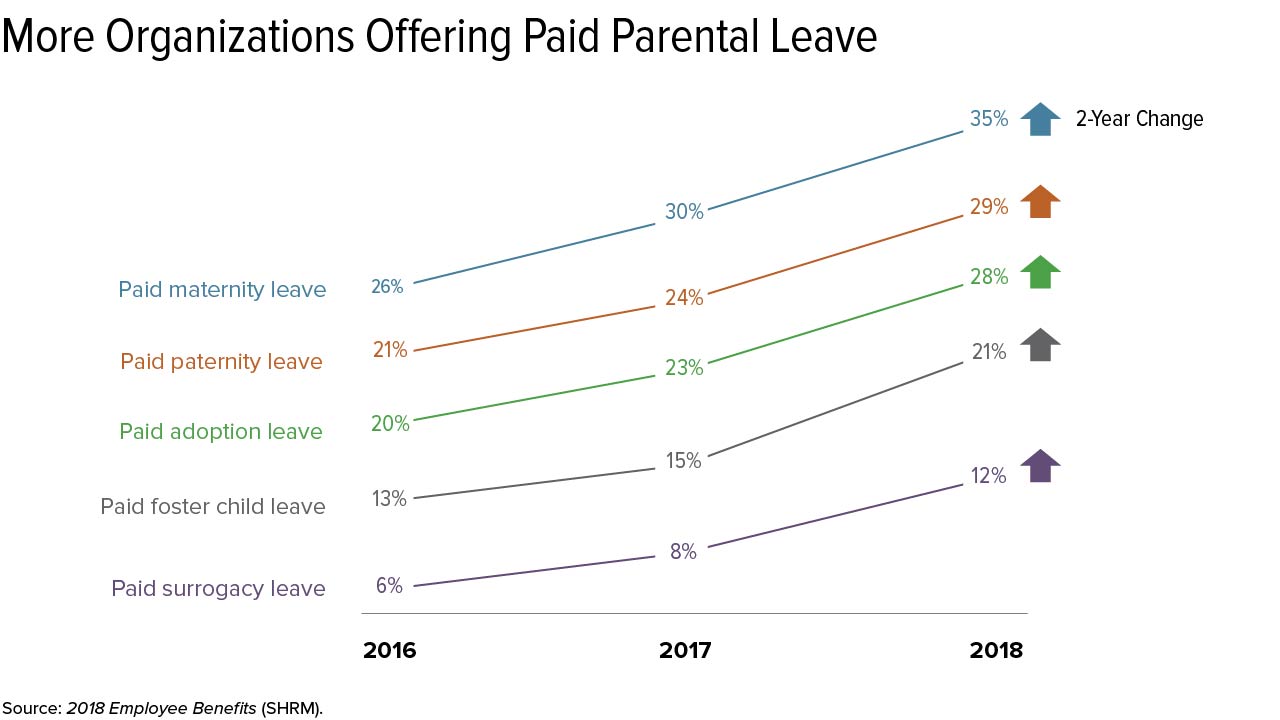To Improve Gender Equality, Help Men Take Parental Leave
Employers should support both men's and women's family leave

Employers serious about building gender equality in their organizations may offer paternity leave to new fathers in addition to maternity leave for new mothers. Further, they should help men take paternity leave as often as women take maternity leave, new research indicates.
The 2018 Global Parental Leave report, released in September by HR consultancy Mercer, shows that in the G-7 countries (Britain, Canada, France, Germany, Italy, Japan and the United States) at least 23 percent of men could be taking paid paternal leave but are not. The report draws on responses from almost 1,000 employers.
"These findings represent a missed opportunity for those employers and employees not fully embracing paternity leave," said Carole Jackson, a principal at Mercer. "Parental leave has significant benefits for women, men and their children in terms of increased well-being, and for companies in terms of addressing the gender gap."
Jackson described four steps to help employers take a more inclusive approach to paternal and parental leave:
- Have parental-leave policies in place for men. Expand paternity policy to match maternity policy or, better yet, implement a nongender-based parental-leave policy.
- Help leadership understand and support paternal leave. Even the most generous paternity leave will not be used if leaders don't genuinely support it.
- Build a culture that supports paternal leave. Many companies will require significant education to encourage men to take leave. Directly confront the notion that child care is "women's work."
- Provide more education, resources and support for line managers. It is critical to get line managers on board with any policy.
Likewise, a 2014 study by the Boston College Center for Work and Family (BCCWF) found that, of the nearly 3,000 fathers interviewed or surveyed, most take only about one day of leave to bond with their new children for every month the typical mother takes. The researchers noted that, on average, "the greater the support for fathers taking time off after the birth of their children" by the workplace culture and immediate manager, "the more time that fathers took off."
[SHRM members-only how-to guide: How to Develop and Administer Paid Leave Programs]
Paid Parental Leave on the Rise
The BCCWF study found that 86 percent of employed fathers said they would not take available paternity leave unless at least 70 percent of their salary was paid.
Employers have responded in recent years by increasingly offering paid paternity leave, according to the Society for Human Resource Management (SHRM) 2018 Employee Benefits survey report. SHRM polled a random sample of its members during the first quarter of 2018 for the survey and received more than 3,500 responses.

Andy Przystanski, content marketing manager at HR tech firm Namely, expects a growing number of businesses to offer an equal share of paid parental leave to mothers and fathers in 2019. "While employers across the country are making the move voluntarily, it's safe to say that local governments have given them a nudge," Przystanski recently blogged.
California, New Jersey, New York, Rhode Island, Washington and several municipalities have enacted and are phasing in paid-family-leave laws, while federal paid-leave proposals are winding their way through Congress.
The Gap Between Policies and Practices
Despite the increased availability of paid leave, working women in the U.S. reported taking only 52 percent of available family leave in 2018, and working men reported taking even less: 32 percent.
In December, these results were reported in Expecting More Than a Baby: Closing the Employee Experience Gap for Working Parents, based on a survey of 1,036 employed parents in the U.S. The study was sponsored by Talking Talent, a consultancy focused on workplace gender diversity.
Among other findings:
- Syncing policies and practices. An overwhelming majority (76 percent) of working parents said that their organization has policies that support parental leave. But 56 percent of parents report a significant gap between their organization's stated support for leave and the begrudging attitudes they encountered when they requested time off. Men (65 percent) were more likely than women (48 percent) to make this point.
- Changing the culture. Most parents said they would have taken a longer parental leave if they had seen co-workers do so (72 percent of men and 56 percent of women). And more than half of all respondents (57 percent) said they would have treated their leave differently if they'd had manager support.
- Convincing new dads. Seventy-four percent of parents agreed that making parental leave more attractive to fathers is key to helping mothers progress in their careers. Yet 63 percent of men believe that taking extended parental leave would be detrimental to their careers.
The results suggest that paid leave isn't just a recruitment tool but also contributes to employee engagement and retention. It's also a critical tool to effectively close the pay gap, given that research continues to demonstrate how family obligations borne disproportionately by women widen the gender-pay gap.
The Talking Talent report, for instance, cited research by University of Massachusetts professor Michelle Budig showing that while men's earnings increased when they had children, women's earnings decreased by 4 percent for each child.
Organizations "will continue to struggle with a lack of female leadership in the C-suite if workplace norms around parental leave continue to reinforce the message that women are the primary caretakers and men should place work over their parental responsibilities," said Teresa Hopke, CEO of Talking Talent.
Working parents "are expecting more than a baby," she pointed out. "They're expecting paid family-bonding time and cultural support to actually use the time allotted to them."
Given that fathers, in particular, believe they're penalized for taking leave, "we can no longer focus our efforts on just supporting women who want to 'have it all.' All parents want to have it all," Hopke said.
Organizations that fail to address this perceived fatherhood penalty, she noted, "may experience new retention and engagement hurdles as men look for workplaces where all working parents are supported."
[Visit SHRM's resource page on paid time off.]
Related SHRM Articles:
'Best Companies for Dads' Spotlights Exemplary Support for Working Fathers, SHRM Online, December 2018
Family Obligations Widen Gender-Pay Gap, Research Suggests, SHRM Online, December 2018
An organization run by AI is not a futuristic concept. Such technology is already a part of many workplaces and will continue to shape the labor market and HR. Here's how employers and employees can successfully manage generative AI and other AI-powered systems.



